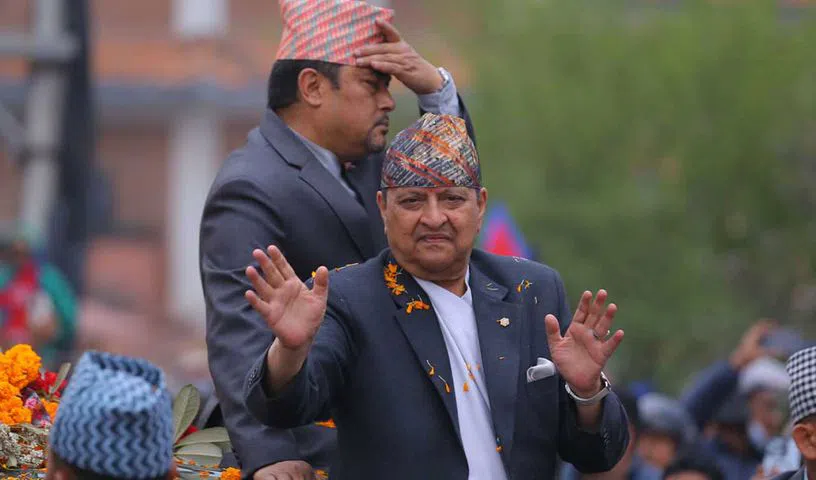
While the recent turn of events may surprise some, Nepal’s overwhelming commitment to its republican system remains clear
By Dhananjay Tripathi
March is one of the best times to visit Nepal, with mild temperatures and clear skies offering a picturesque backdrop. However, while nature remains serene, Nepal’s political landscape has been anything but calm. A storm has brewed in recent weeks, sparked by the return of Nepal’s last monarch, King Gyanendra Shah, who surprisingly received a resounding welcome in the capital, Kathmandu.
Reports estimate that over 10,000 enthusiastic supporters gathered at the airport to express their unwavering loyalty to the former king. Even as March drew to a close, pro-monarchy groups staged protests that turned violent, resulting in the tragic deaths of two individuals. This unrest has reignited a debate about monarchy in a country that abolished it in 2008 when the Constituent Assembly declared Nepal a federal democratic republic, ending over two centuries of royal rule. At the time, the transition was met with widespread optimism as Nepalis anticipated a brighter future under a new system of governance.
Monarchy and Republic
The warm reception for King Gyanendra and the violent protests that followed raise a critical question: Were things better under the monarchy? Why are some people in Nepal rallying behind a system discarded over decades ago? To answer these, economic indicators provide some insight.
During the monarchy, centralised control and a lack of accountability allowed the ruling elite to amass wealth while the majority languished in poverty. The Rana regime (1846–1951), for instance, was notoriously exploitative. Under the agrarian economy, which employed over 80% of the population, the Rana rulers implemented the Birta system, granting tax-free land to their families and allies. This left most peasants as tenants or sharecroppers with little economic agency. Rana rulers also hardly paid attention to the development of Nepal and left it with poor social and physical infrastructure.
The subsequent Shah dynasty marked a slight improvement, but Nepal’s economic fortunes remained stagnant. In 1990, under King Birendra’s constitutional monarchy, GDP per capita was a mere $200, classifying Nepal as a low-income country. By 2008, the final year of monarchical rule, it had risen to just over $450 — barely doubling in nearly two decades and still falling short of meaningful progress.
In contrast, the post-monarchy era has seen significant economic strides. By 2023, Nepal’s GDP per capita reached $1,324, reflecting an average annual growth rate of 4.95%. In just one-and-a-half decades, incomes have nearly tripled, bolstered by increased international investment and economic diversification. Nepal’s Human Development Index (HDI) also improved, rising from 0.491 in 2010 to 0.602 in 2021.
The India rhetoric, a familiar strategy of some politicians in Nepal, risks overshadowing the real issues — unemployment, corruption and instability — that demand the government’s attention
However, not all indicators paint a rosy picture. Poverty reduction, a noticeable spot during the constitutional monarchy (declining from 42% in 1995-96 to 25.2% in 2003-04, an annual drop of 2.1%), has slowed considerably since 2008. Between 2010-11 and 2024, poverty fell from 21.6% to 20.27%, a meagre 0.1% annual reduction. In this, let us not discount the two fairly difficult phases of Nepal — the massive earthquake (2015) and the Covid-related economic slowdown. While income distribution has become more equitable in the republic era, this stagnation in poverty alleviation remains a glaring concern.
The Faultlines
Despite the republic’s economic gains, underlying issues fuel discontent. Political instability tops the list. Since 2008, Nepal has seen 13 different governments, with no government completing a full five-year term. This constant upheaval has bred disillusionment among citizens. Rampant corruption, a persistent complaint, further erodes trust in the system.
Another pressing concern is unemployment, particularly among the youth. While the overall unemployment rate stands at 10%, it soars to 20% for young Nepalis (age group of 15-24) in 2023. The economy’s heavy reliance on remittances — accounting for 26% of GDP — signals sluggish domestic growth and limited job creation, exacerbating frustration.
Could these factors explain the pro-monarchy sentiment? It’s hard to say definitively, but they likely contribute to public disillusionment. Additionally, genuine ideological support for the monarchy and a Hindu Rashtra (Hindu state) in some quarters of Nepal cannot be dismissed. The Rastriya Prajatantra Party (RPP), a pro-monarchy and Hindu nationalist group, has gained traction, securing 5.3% of the vote and 14 parliamentary seats in the 2022 elections, making it the fifth-largest party in parliament. Active in recent protests, the RPP draws support from conservative upper-caste elites.
What about India?
The March 9 rally welcoming King Gyanendra featured posters of Uttar Pradesh Chief Minister Yogi Adityanath. As per reports, King Gyanendra had a meeting with Adityanath in India, and this sparked speculation in the political circle of Nepal. Some commentators in Nepal, therefore, had portrayed the rally as a sign of “India hand”. However, this claim appears more as a political tactic to stoke nationalist sentiment and discredit the pro-monarchy movement.
While a few in India may sympathise with Hindu nationalism in Nepal, there’s little evidence of a broader political agenda. Moreover, in India, there is overwhelming support for peace, prosperity and democracy in Nepal. The India rhetoric, a familiar strategy of some politicians in Nepal, risks overshadowing the real issues — unemployment, corruption and instability — that demand the government’s attention.
The resurgence of pro-monarchy activity has captivated observers both within and beyond Nepal. A nation with a hard-fought history of democratic struggle, Nepal is unlikely to embrace any rollback of its republic. Yet, the global rise of conservative politics, coupled with unmet public aspirations, provides fertile ground for groups like the RPP.
While the recent turn of events may surprise some, Nepal’s overwhelming commitment to its republican system remains clear. Addressing the root causes of discontent — rather than leaning on conspiracy theories — offers the best path forward for the country’s stability and prosperity.







